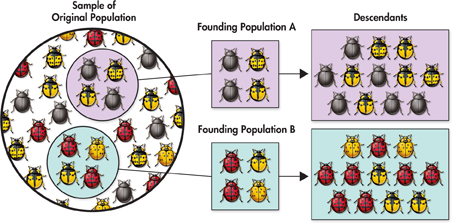Genetic Drift
 What is genetic drift?
What is genetic drift?
Natural selection is not the only source of evolutionary change. In small populations, an allele can become more or less common simply by chance.  In small populations, individuals that carry a particular allele may leave more descendants than other individuals leave, just by chance. Over time, a series of chance occurrences can cause an allele to become more or less common in a population. This kind of random change in allele frequency is called genetic drift.
In small populations, individuals that carry a particular allele may leave more descendants than other individuals leave, just by chance. Over time, a series of chance occurrences can cause an allele to become more or less common in a population. This kind of random change in allele frequency is called genetic drift.
Genetic Bottlenecks Sometimes, a disaster, such as disease, can kill many individuals in a population. Just by chance, the smaller population's gene pool may have allele frequencies that are different from those of the original gene pool. If the reduced population later grows, its alleles will be different in frequency from the original population's. The bottleneck effect is a change in allele frequency following a dramatic reduction in the size of a population. A severe bottleneck effect can sharply reduce a population's genetic diversity.
The Founder Effect Genetic drift may also occur when a few individuals colonize a new habitat. These founding individuals may carry alleles that differ in relative frequencies from those of the main population, just by chance. The new gene pool may therefore start out with allele frequencies different from those of the parent gene pool, as shown in Figure 17–8. This situation, in which allele frequencies change as a result of the migration of a small subgroup of a population, is known as the founder effect.
BUILD Vocabulary
ACADEMIC WORDS The adjective random means “lacking a pattern” or “happening by chance.” A random change is a change that happens by chance.
One example of the founder effect is the evolution of several hundred species of fruit flies on different Hawaiian islands. All those species descended from the same mainland fruit fly population. However, species on different islands have allele frequencies that are different from those of the original species.

FIGURE 17–8 Founder Effect This illustration shows how two small groups from a large, diverse population could produce new populations that differ from the original group. Compare and Contrast Explain why the two populations of descendants are so different from one another.
Table of Contents
- Formulas and Equations
- Applying Formulas and Equations
- Mean, Median, and Mode
- Estimation
- Using Measurements in Calculations
- Effects of Measurement Errors
- Accuracy
- Precision
- Comparing Accuracy and Precision
- Significant Figures
- Calculating With Significant Figures
- Scientific Notation
- Calculating With Scientific Notation
- Dimensional Analysis
- Applying Dimensional Analysis




